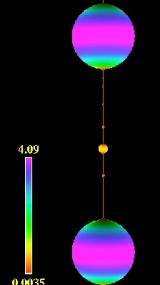September 10, 2010 feature
Physicists investigate fate of five-dimensional black strings

(PhysOrg.com) -- While black holes in four-dimensional space-time are stable and can persist for a long time, their higher-dimensional analogues are usually unstable. One such theoretical analogue is a five-dimensional black string, which is unstable to perturbations and tends to decay into different forms. But like all unstable "black objects," it's difficult to determine what the end state of the perturbed system might be. Using a new computer code, physicists have been able to simulate the evolution of five-dimensional black strings well beyond earlier studies, leading them to predict that the strings eventually turn into five-dimensional black holes.
The physicists, Luis Lehner from the Perimeter Institute for Theoretical Physics, the University of Guelph (both in Ontario, Canada), and the Canadian Institute for Advanced Research, along with Frans Pretorius from Princeton University, have published their study in a recent issue of Physical Review Letters.
The final fate of higher-dimensional black strings has been questioned many times since the early 1990s, when Gregory and Laflamme first realized that these objects are unstable (subject to what is now called the Gregory-Laflamme instability). At that time, Gregory and Laflamme conjectured that unstable black strings might eventually be “pinched off” at periodic intervals, resulting in a sequence of black holes. This idea fits with entropic considerations, since a sequence of black holes has higher entropy than a black string. However, some scientists later proved that black strings could not pinch off in a finite time as measured along the event horizon. This finding cast doubt on the possibility of a pinch-off that could be observed, and many scientists began investigating other possibilities.
One of the later conjectures, which was based on a numerical simulation, found that an unstable black string can evolve into a “necklace” of spherical black holes connected by black string segments. Although this evolution involves pinch-offs, it avoids the conclusions of the no-pinch-off proof due to a technical caveat. However, the code that was used for this investigation crashed before scientists could infer a final state.
In their new study, Lehner and Pretorius developed a new code that could extend this investigation without crashing. The simulation again showed the black string evolving into black holes connected by thin string segments. Since the string segments are themselves unstable, smaller black holes begin forming on these segments, and the pattern repeats on ever-smaller scales. As the self-similar cascade continues, smaller and smaller black holes form on the string segments and the string segments get thinner, until they are both arbitrarily small.
The researchers ran the simulation until they had to stop due to high computational requirements. But the simulations revealed enough to allow the physicists to estimate that the cascade will terminate at a finite time. As they explained, the curvature of the black holes increases as the string radius decreases, which leads to a naked singularity.
If quantum gravity resolves this singularity, several black holes should emerge. Then, small perturbations in the extra dimension would cause these black holes to merge into one black hole, which would be the final state of the black string.
The result is especially interesting because it could violate the cosmic censorship hypothesis. Formulated in 1969 by Roger Penrose, the cosmic censorship hypothesis says that there are no naked singularities other than the Big Bang singularity; all other singularities must be isolated from the rest of the universe by some kind of horizon. The purpose of cosmic censorship is to preserve the universe's causality, since a naked singularity would make causality break down and make it impossible to predict the behavior of future space-time based on the behavior of past space-time.
“I would say the thing of most import about our work is it establishes that, at least in five dimensions, there are 'reasonable' solutions to Einstein's field equations, i.e., solutions that don't have naked singularities and aren't special in any way, yet they naturally evolve to a nakedly-singular state,” Pretorius told PhysOrg.com. “Whether higher dimensions are key here (or whether they even exist!) is an open question, but at least this shows that the Einstein equations themselves don't possess some 'magical' property that generically would enforce cosmic censorship.”
Lehner added that, although the current study deals with five dimensions, the results are likely the same up to 13 dimensions. The study suggests that perhaps four dimensions is somehow “special” in that that is where cosmic censorship seems to hold its ground. To violate cosmic censorship in four dimensions, an unusual mechanism or unnatural energy source is required. In contrast, in five to 13 dimensions, naked singularities appear naturally with no fine-tuning. This finding may also help physicists find a theory of quantum gravity.
“Some people expect that a theory of quantum gravity, possibly like string theory, should be able to explain the singularities classical general relativity has but cannot itself explain,” said Pretorius. “In that sense, singularities then aren't 'bad,' we just need a better theory. However, the problem here is we don't know what the 'true' theory of quantum gravity is. Thus, if there are naked singularities in nature, there would be phenomena in the universe we can't explain by the theories we have. Some people (like Hawking) view this as 'anathema,' and think cosmic censorship is needed to prevent such a disaster; others (like Thorne), think it would be great if there were (benign) naked singularities, as this would give us a direct look into the inner workings of quantum gravity. I'm in the latter camp!”
More information: Luis Lehner and Frans Pretorius. “Black Strings, Low Viscosity Fluids, and Violation of Cosmic Censorship.” Physical Review Letters 105, 101102 (2010). DOI: 10.1103/PhysRevLett.105.101102
Copyright 2010 PhysOrg.com.
All rights reserved. This material may not be published, broadcast, rewritten or redistributed in whole or part without the express written permission of PhysOrg.com.


















